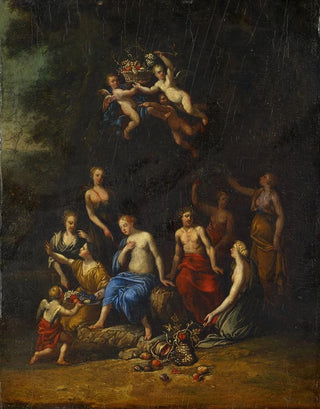Art print | Bacchus and Pomona - Gerard de Lairesse


View from behind

Frame (optional)
Bacchus and Pomona - Gerard de Lairesse – Captivating Introduction
In the rich and complex universe of art history, some works manage to transcend their era, capturing the essence of a culture while remaining timeless. "Bacchus and Pomona" by Gerard de Lairesse is one of these masterpieces. This artwork, which evokes the encounter between the god of wine and the goddess of fruits, illustrates not only the beauty of human forms but also the depth of mythological themes. The depiction of these two emblematic figures, surrounded by lush nature, invites the viewer on a sensory journey into classical mythology. In this art print, every detail is carefully reproduced, allowing for an appreciation of Lairesse's craftsmanship.
Style and uniqueness of the work
Gerard de Lairesse's style is distinguished by a delicate harmony between baroque and classicism. In "Bacchus and Pomona," the artist plays with light and shadow, creating striking contrasts that bring his characters to life. The flowing drapery and the expressions of the figures demonstrate exceptional skill, where each fold of fabric seems to vibrate under a gentle breeze. The composition is carefully balanced, with Bacchus, symbol of intoxication and celebration, majestically standing alongside Pomona, embodying softness and fertility. This dialogue between the two characters results in a subtle interaction, where joie de vivre blends with contemplative serenity. The color palette chosen by Lairesse, both vibrant and nuanced, enhances this atmosphere of harmony and celebration.
The artist and his influence
Gerard de Lairesse, born in the 17th century, established himself as one of the most influential painters of his time. Trained at the Dutch baroque art school, he integrated classical elements into his work, making him a precursor of neoclassicism. His innovative approach to mythological themes and technical mastery inspired many artists. Lairesse was also a theorist of art, writing treatises that helped define the principles

Matte finish

View from behind

Frame (optional)
Bacchus and Pomona - Gerard de Lairesse – Captivating Introduction
In the rich and complex universe of art history, some works manage to transcend their era, capturing the essence of a culture while remaining timeless. "Bacchus and Pomona" by Gerard de Lairesse is one of these masterpieces. This artwork, which evokes the encounter between the god of wine and the goddess of fruits, illustrates not only the beauty of human forms but also the depth of mythological themes. The depiction of these two emblematic figures, surrounded by lush nature, invites the viewer on a sensory journey into classical mythology. In this art print, every detail is carefully reproduced, allowing for an appreciation of Lairesse's craftsmanship.
Style and uniqueness of the work
Gerard de Lairesse's style is distinguished by a delicate harmony between baroque and classicism. In "Bacchus and Pomona," the artist plays with light and shadow, creating striking contrasts that bring his characters to life. The flowing drapery and the expressions of the figures demonstrate exceptional skill, where each fold of fabric seems to vibrate under a gentle breeze. The composition is carefully balanced, with Bacchus, symbol of intoxication and celebration, majestically standing alongside Pomona, embodying softness and fertility. This dialogue between the two characters results in a subtle interaction, where joie de vivre blends with contemplative serenity. The color palette chosen by Lairesse, both vibrant and nuanced, enhances this atmosphere of harmony and celebration.
The artist and his influence
Gerard de Lairesse, born in the 17th century, established himself as one of the most influential painters of his time. Trained at the Dutch baroque art school, he integrated classical elements into his work, making him a precursor of neoclassicism. His innovative approach to mythological themes and technical mastery inspired many artists. Lairesse was also a theorist of art, writing treatises that helped define the principles






